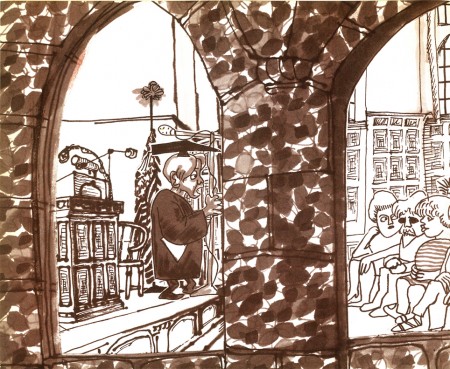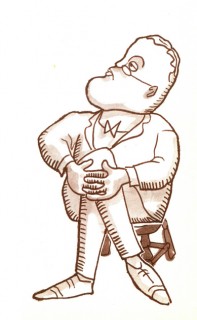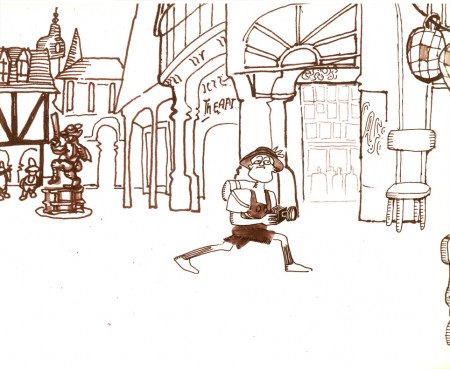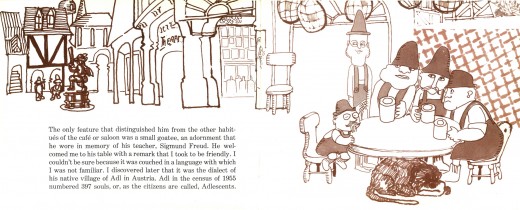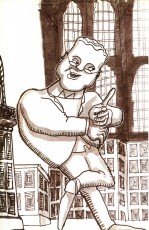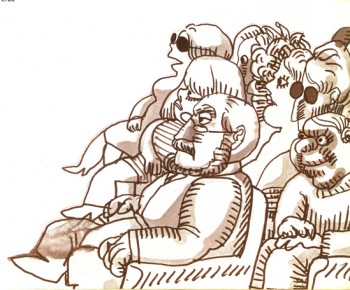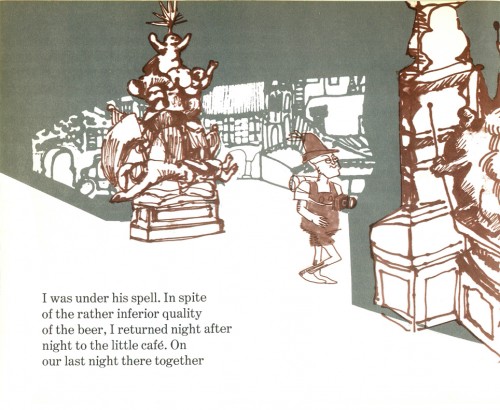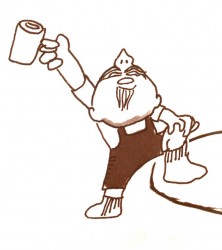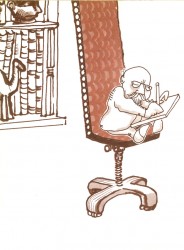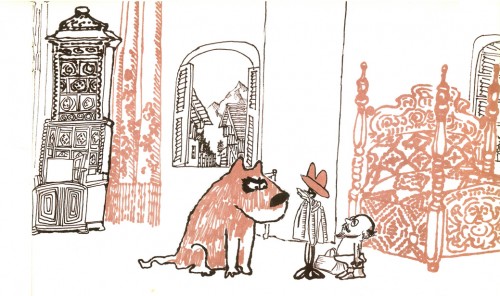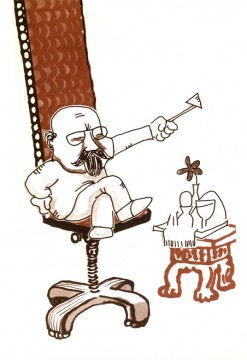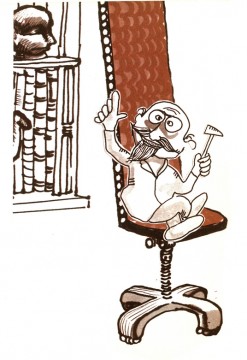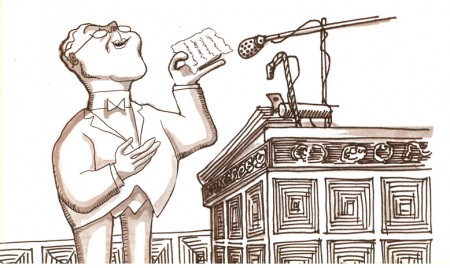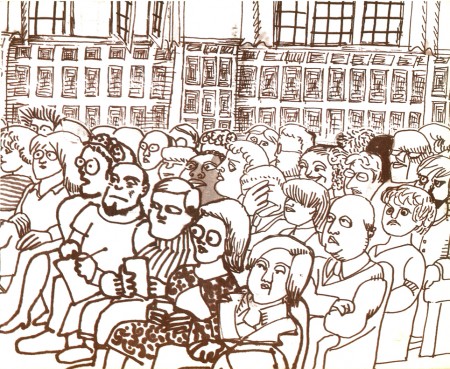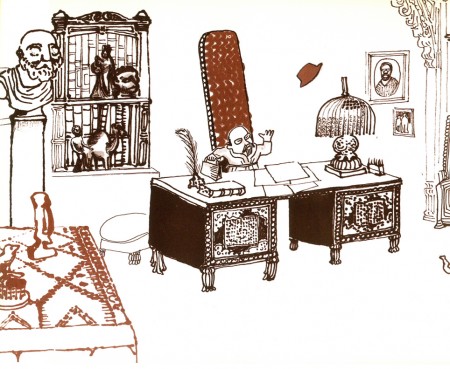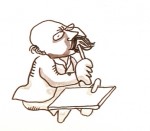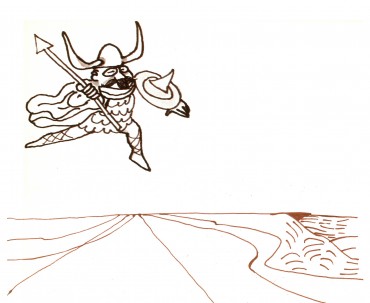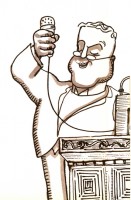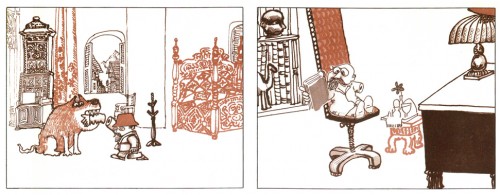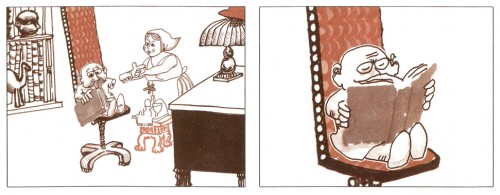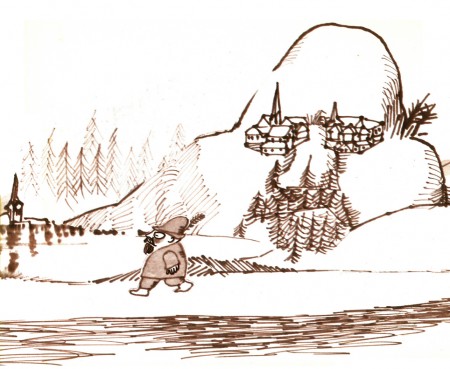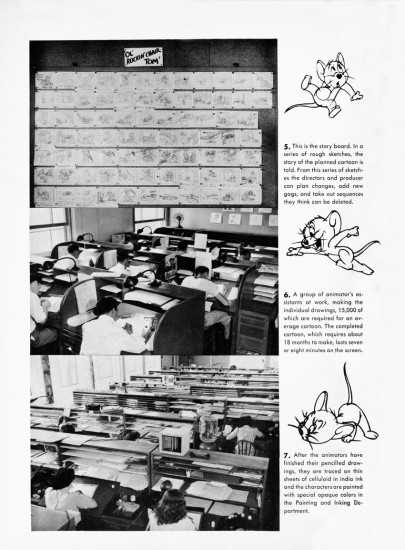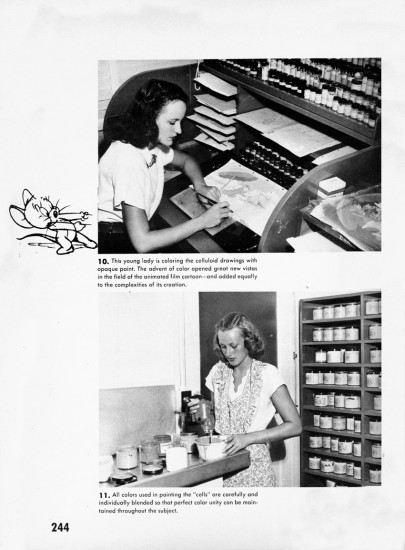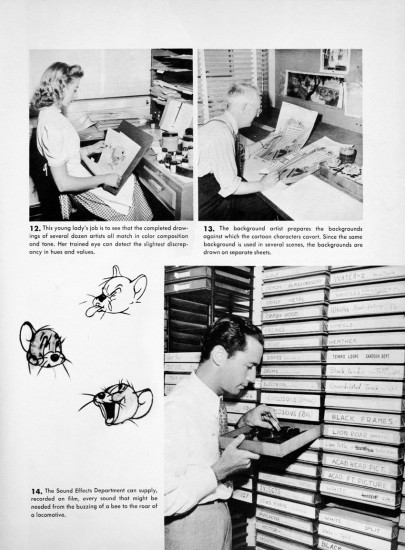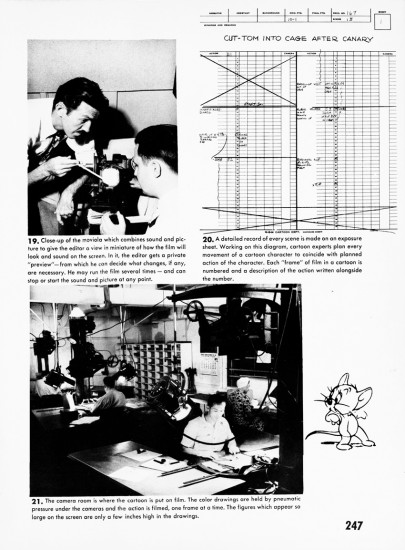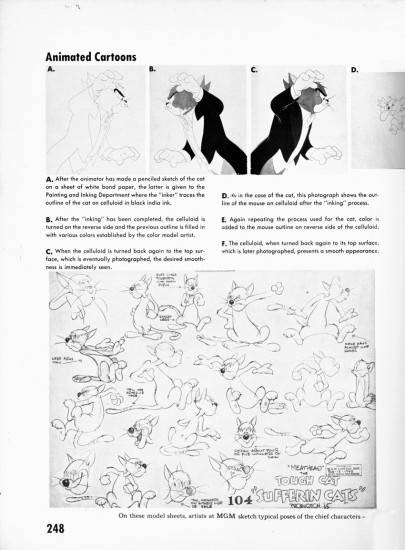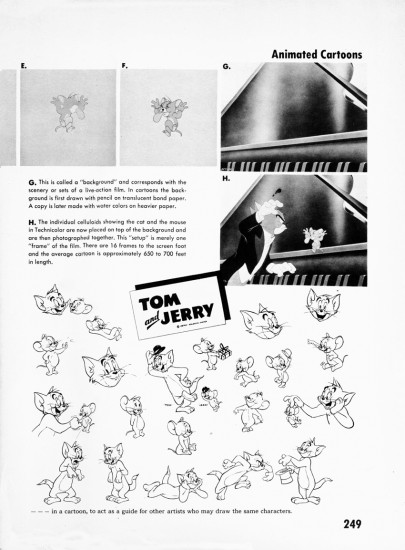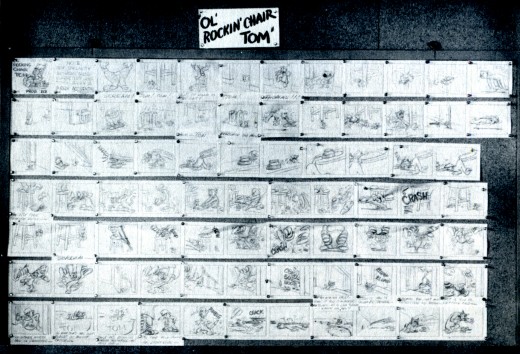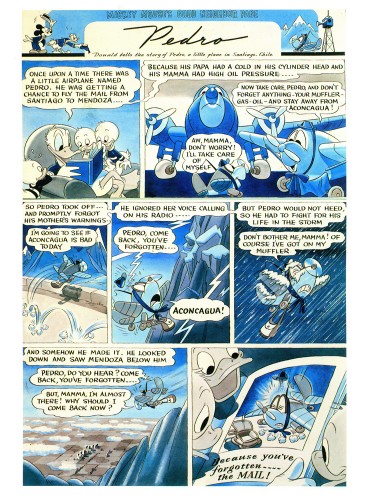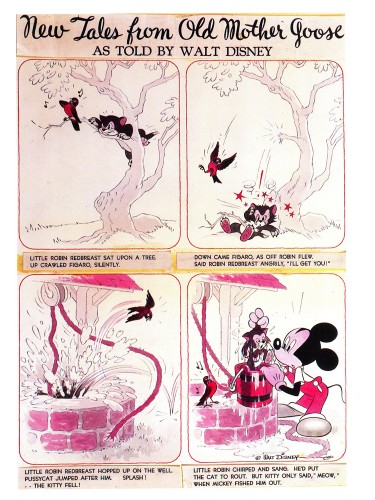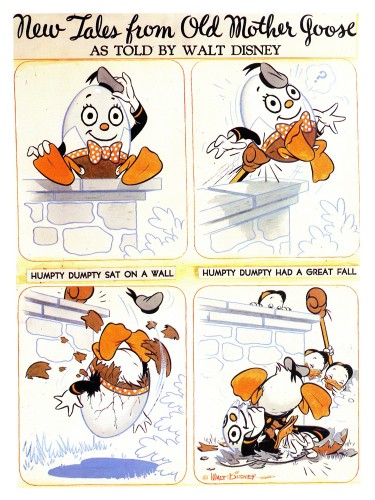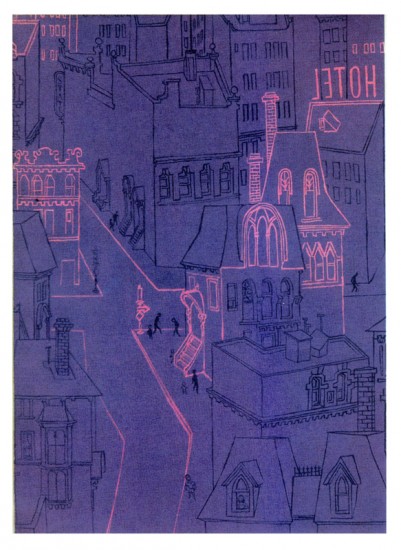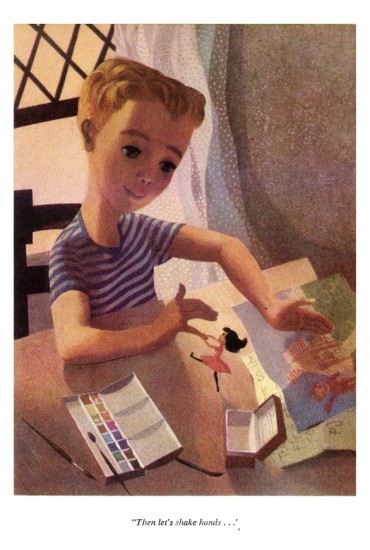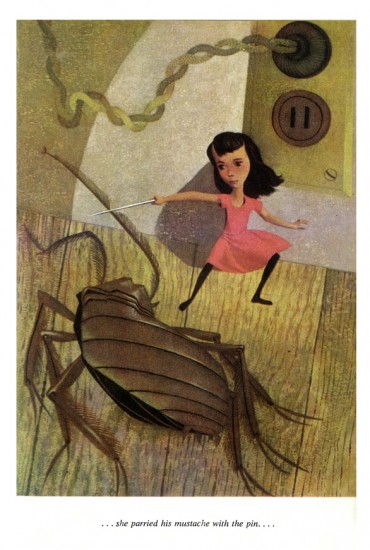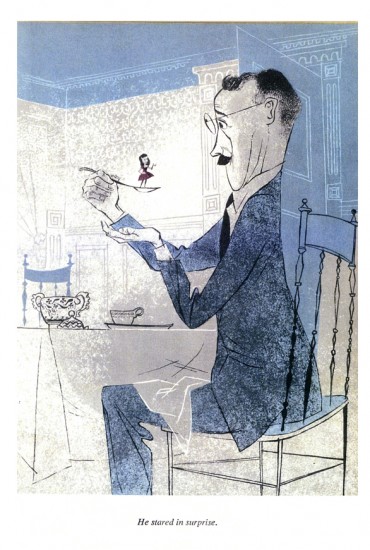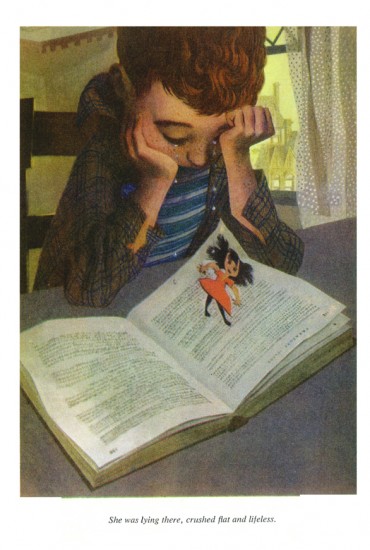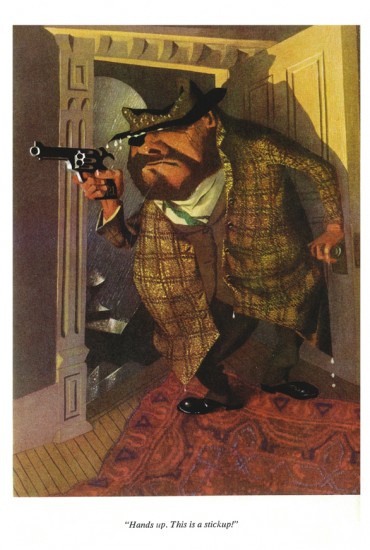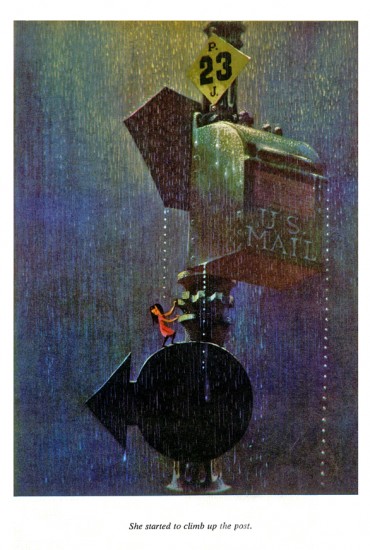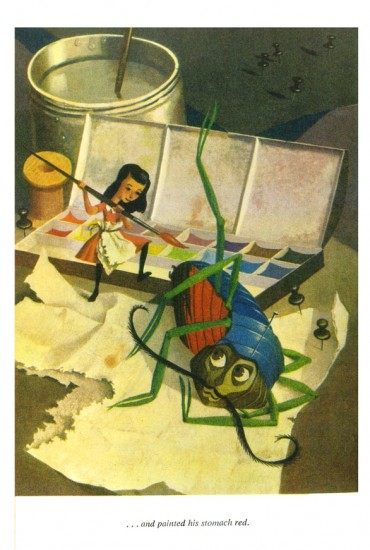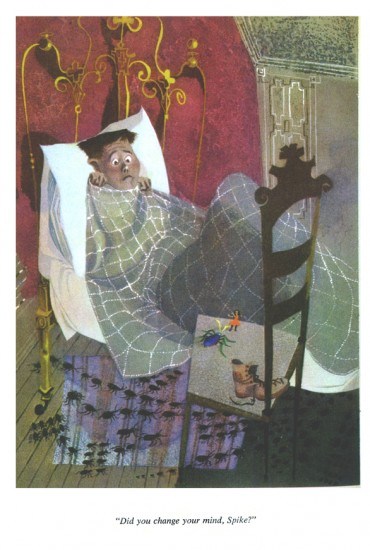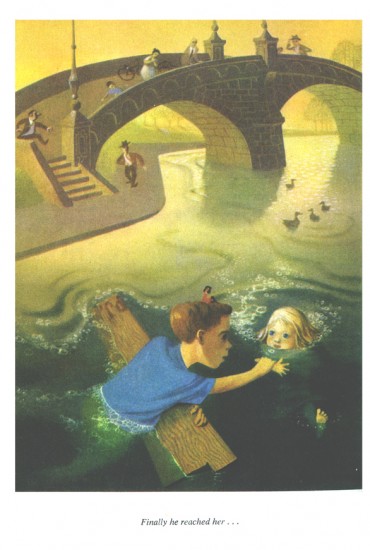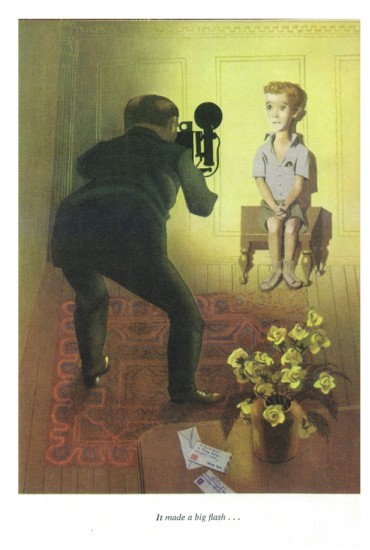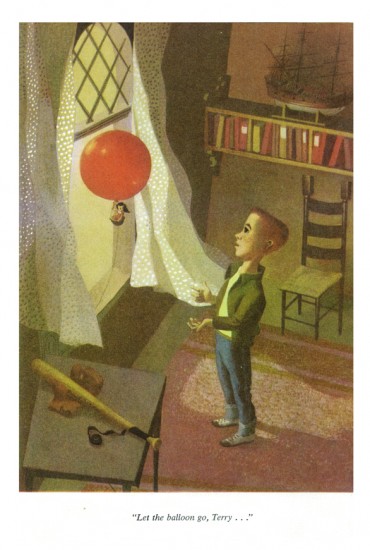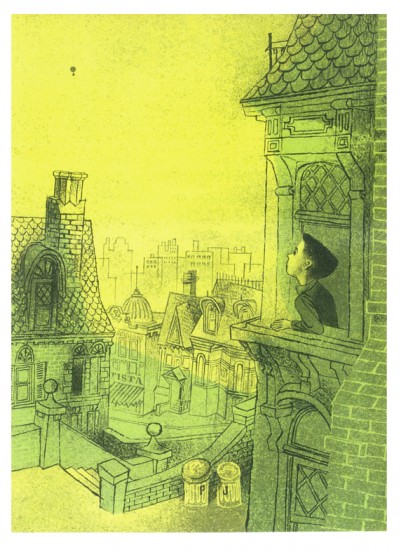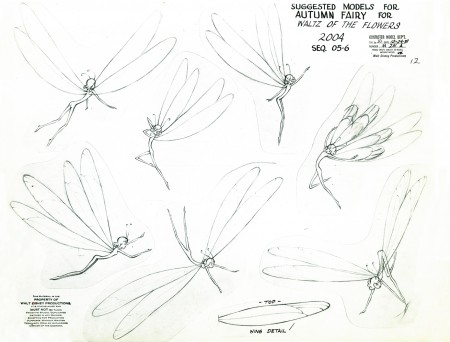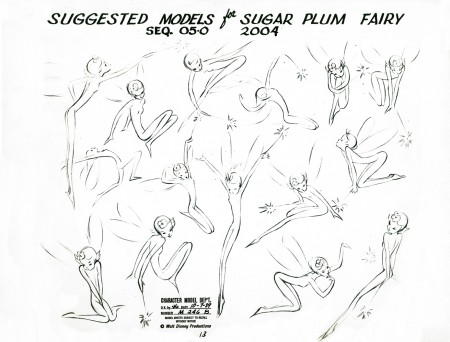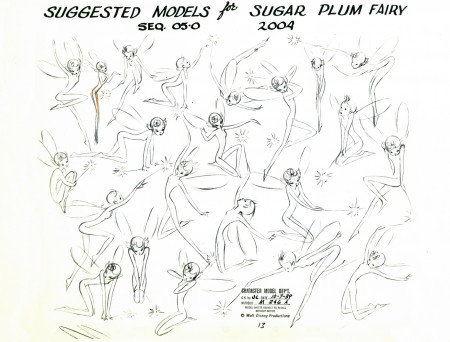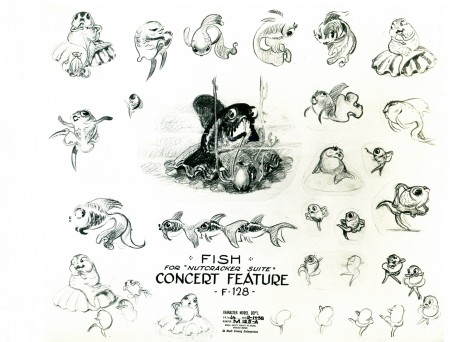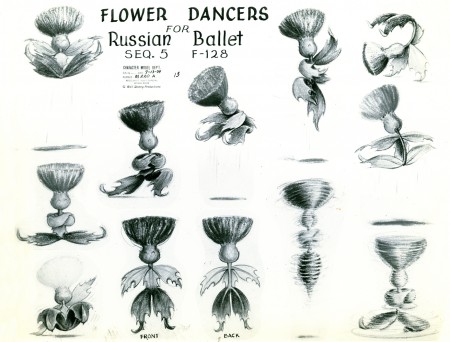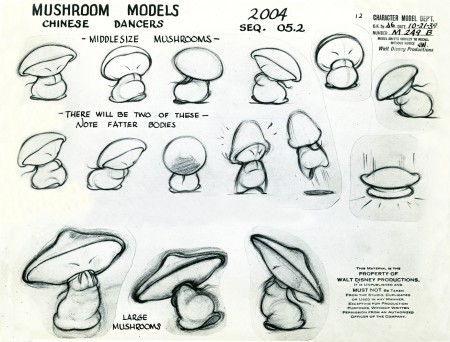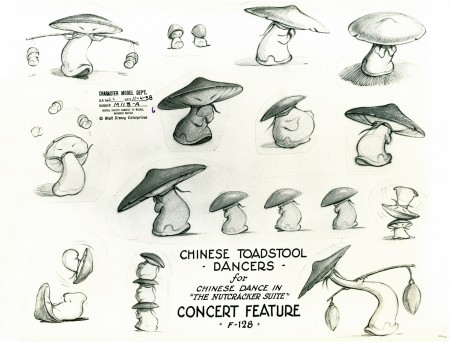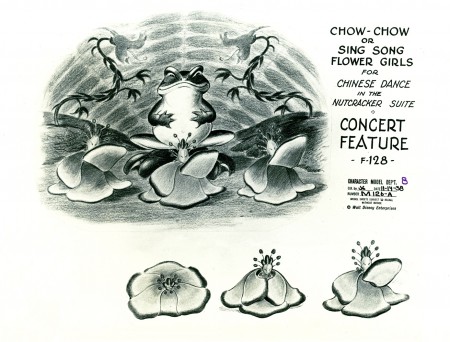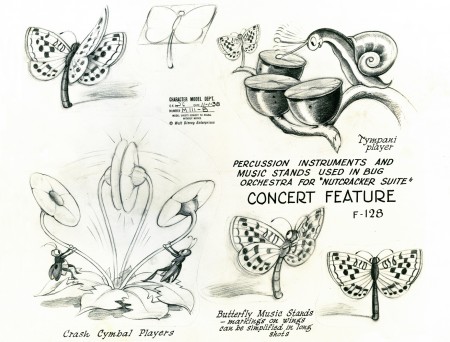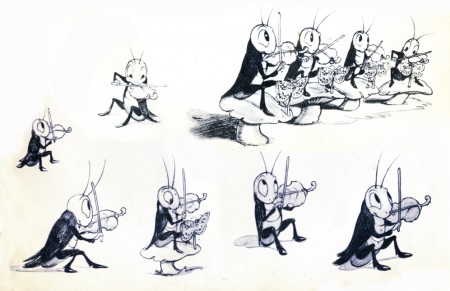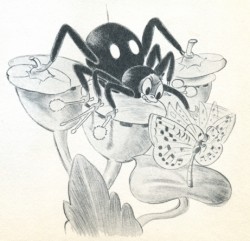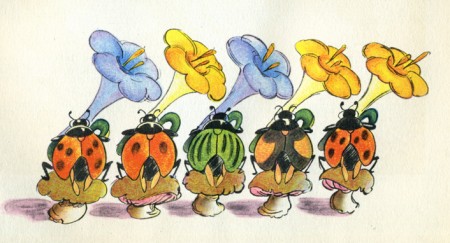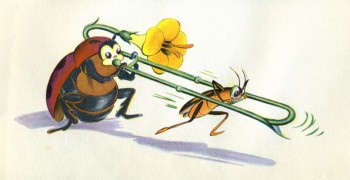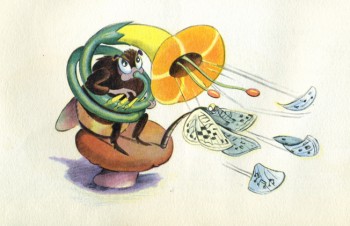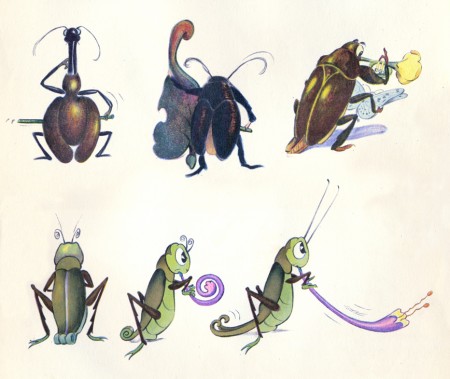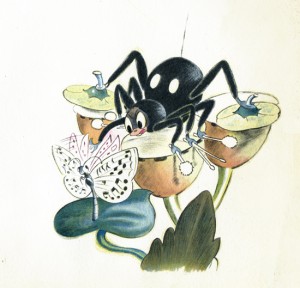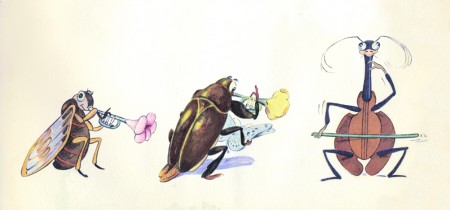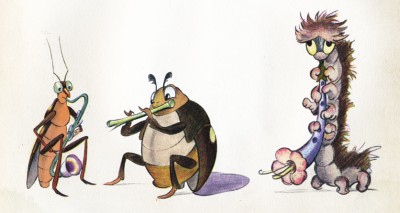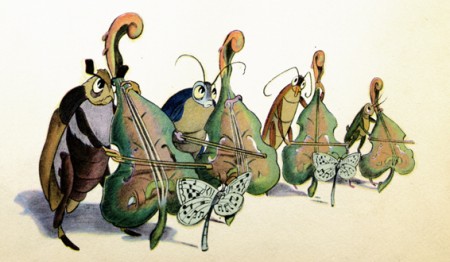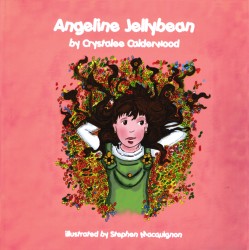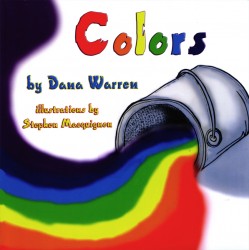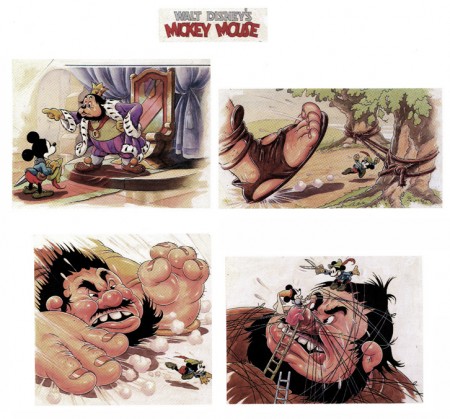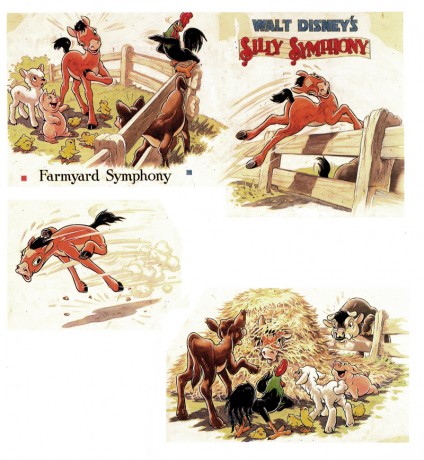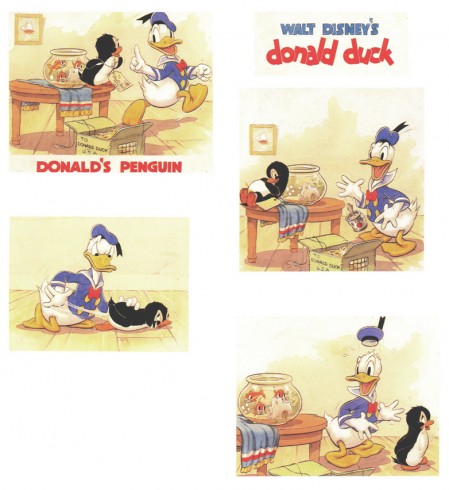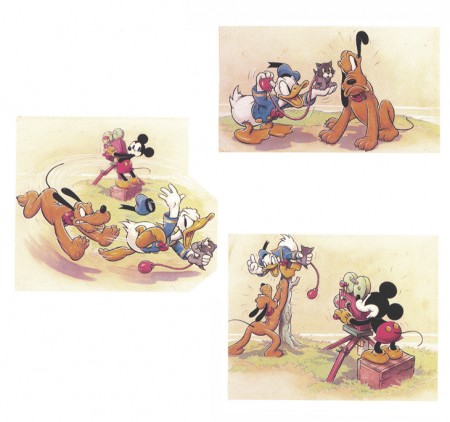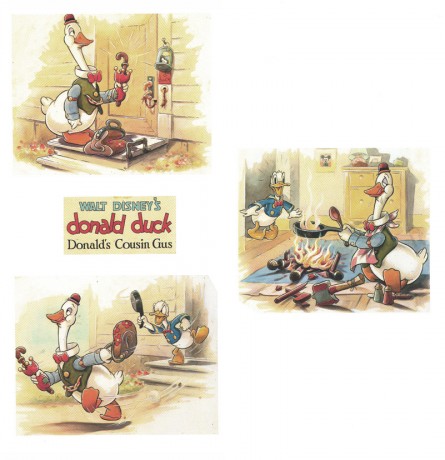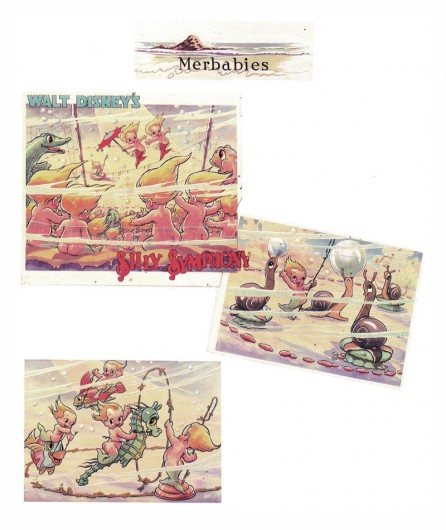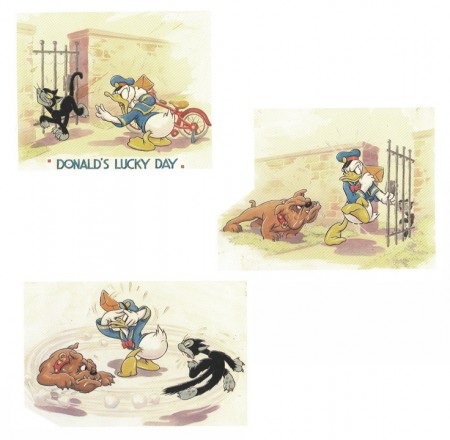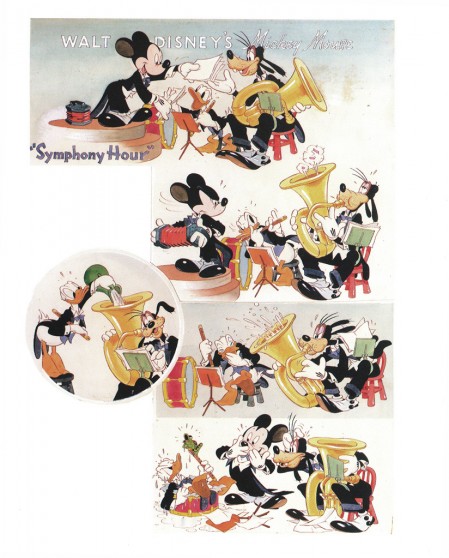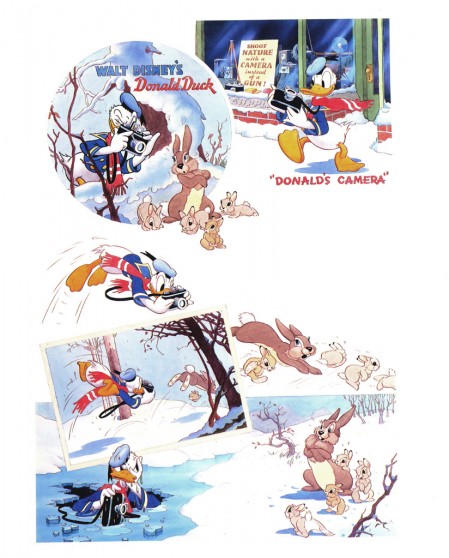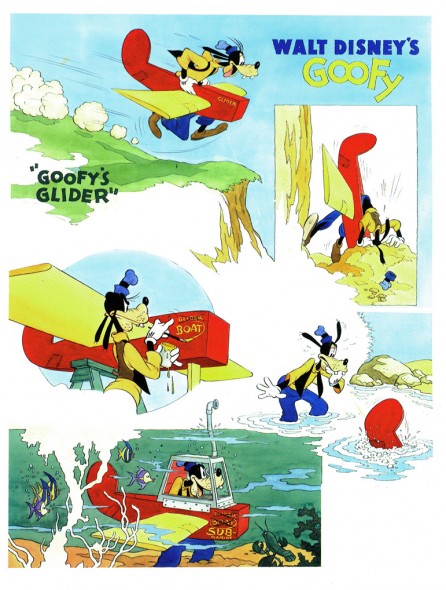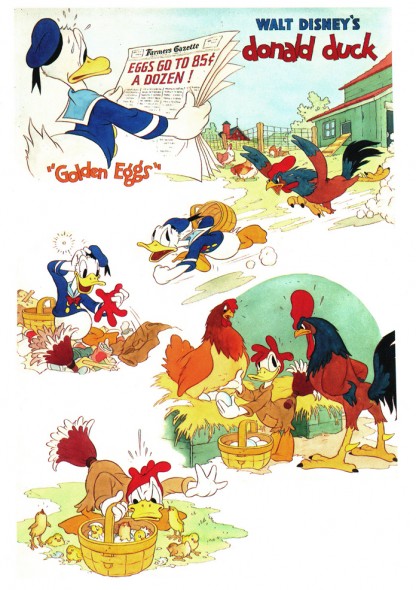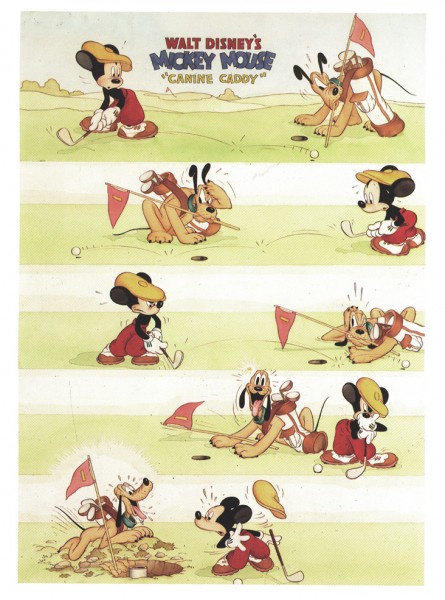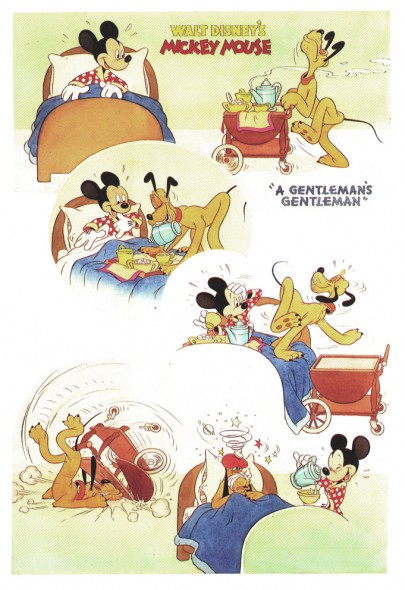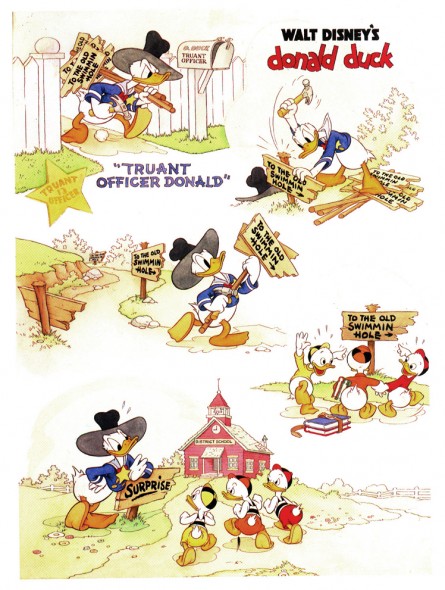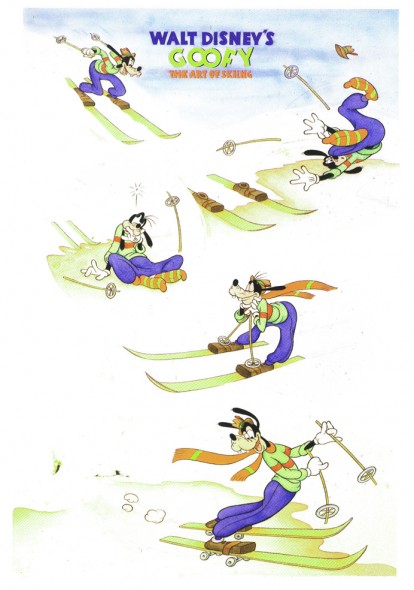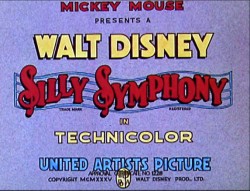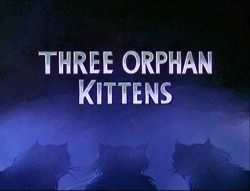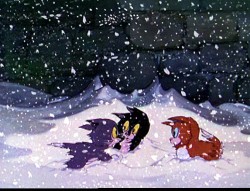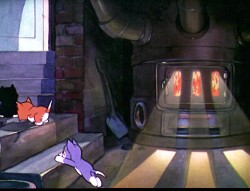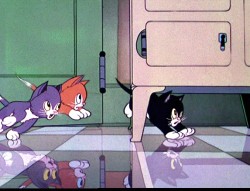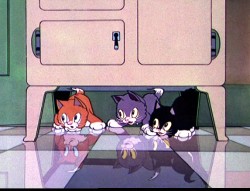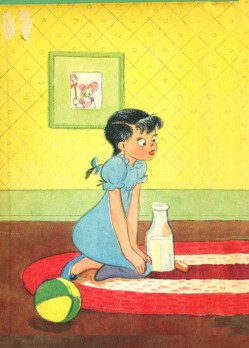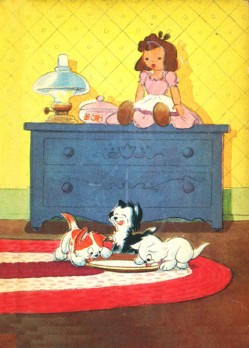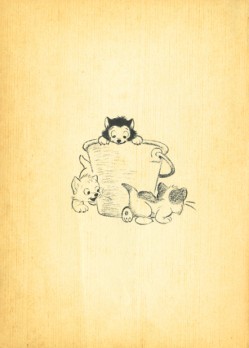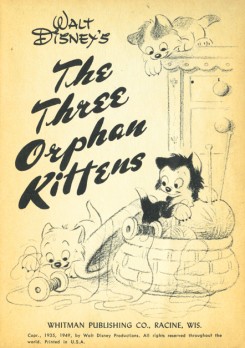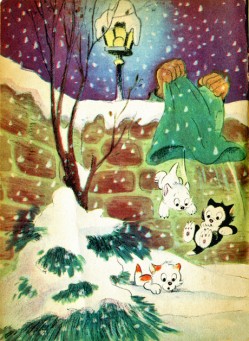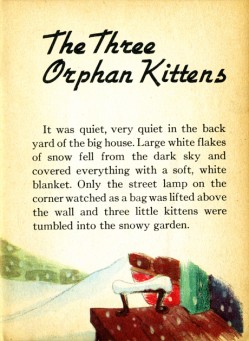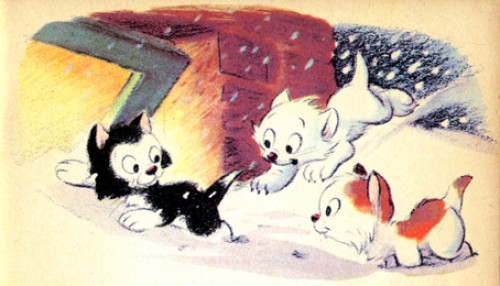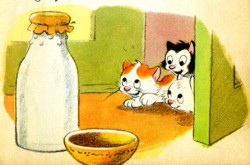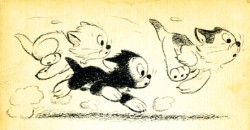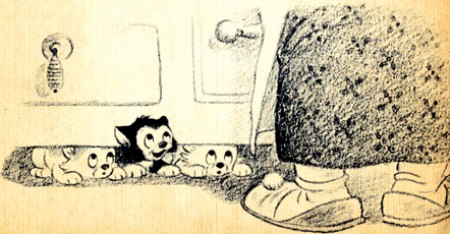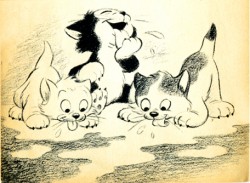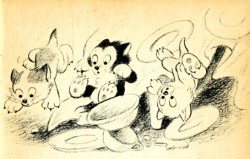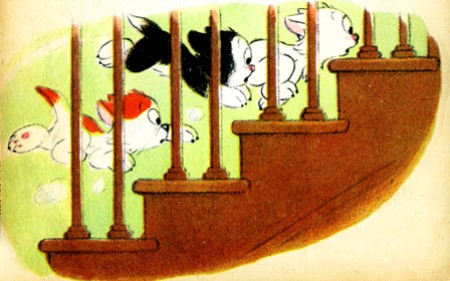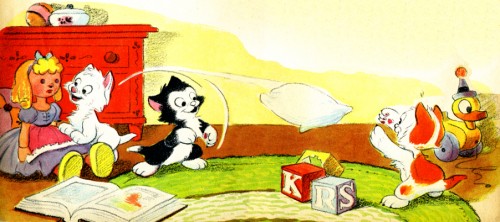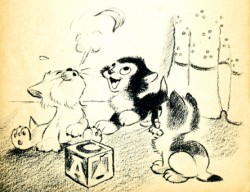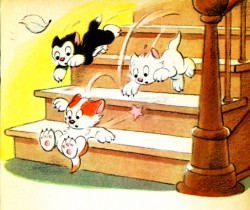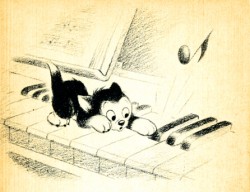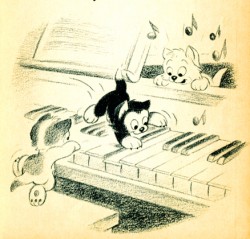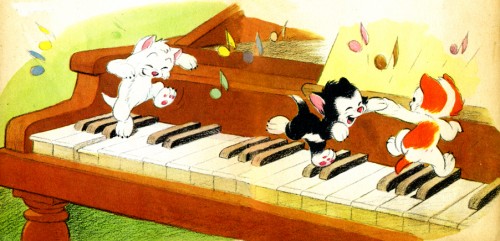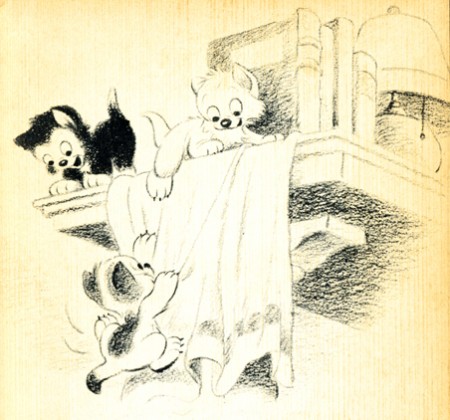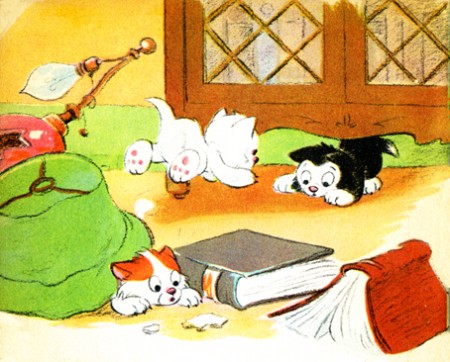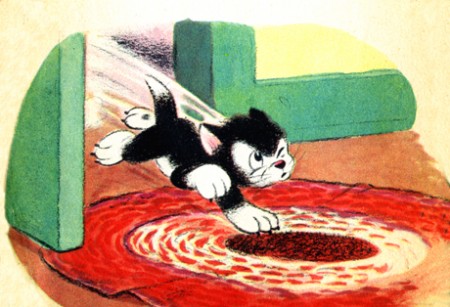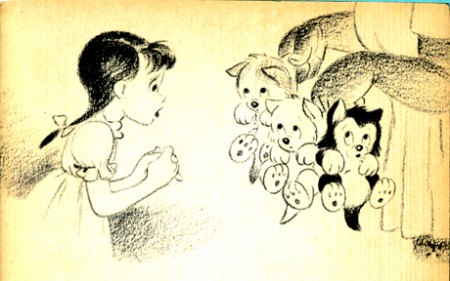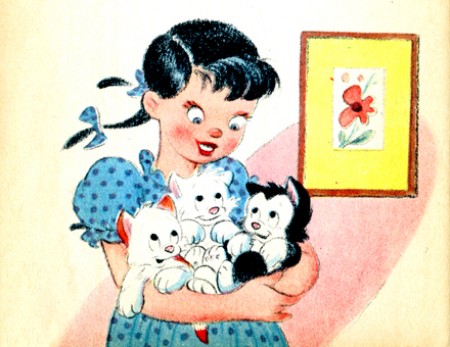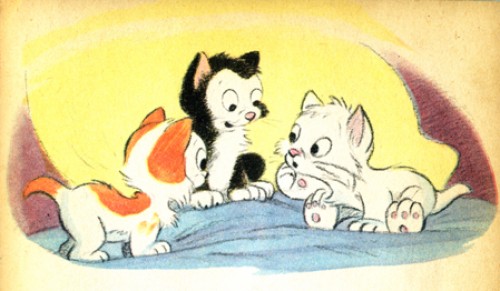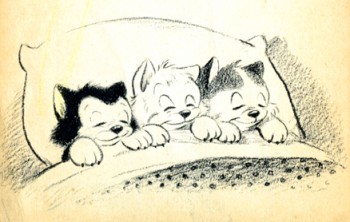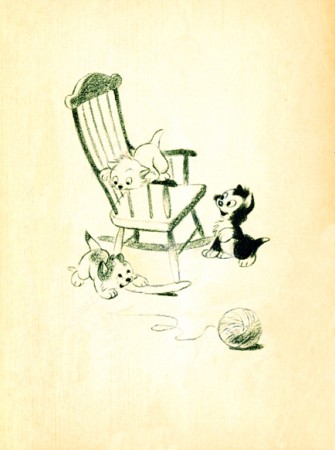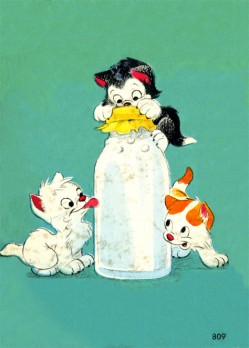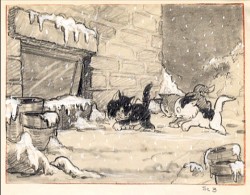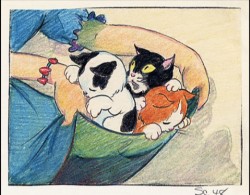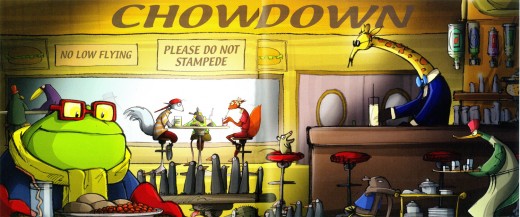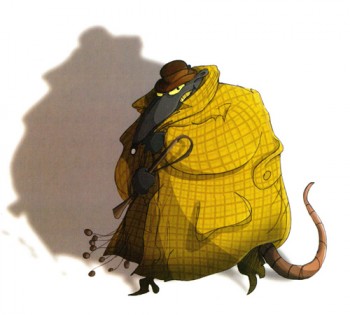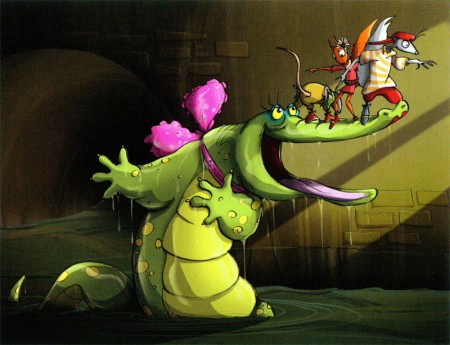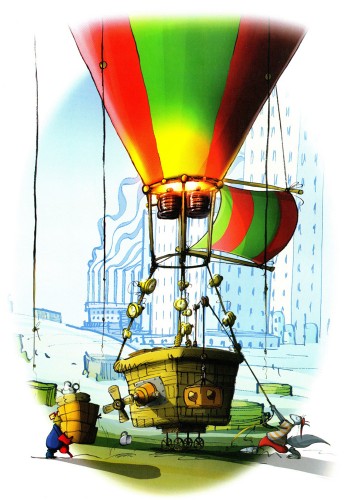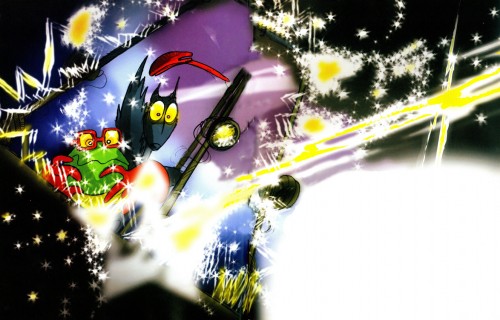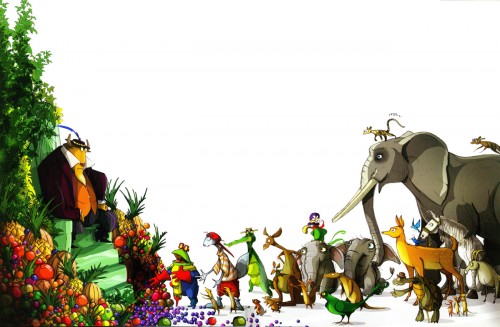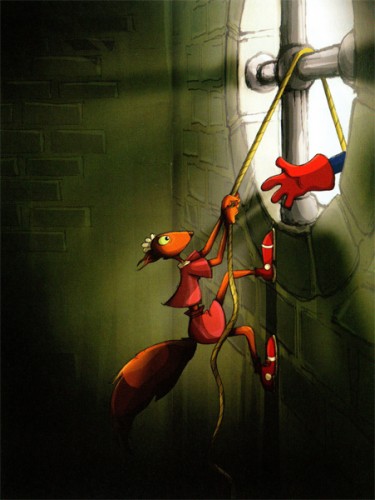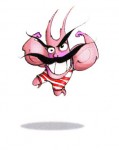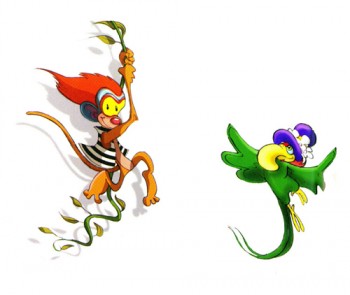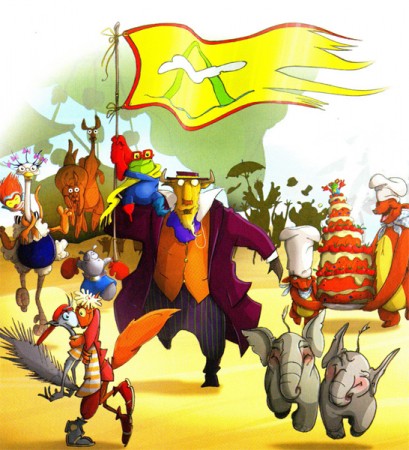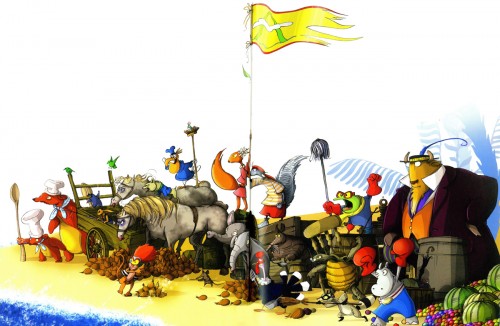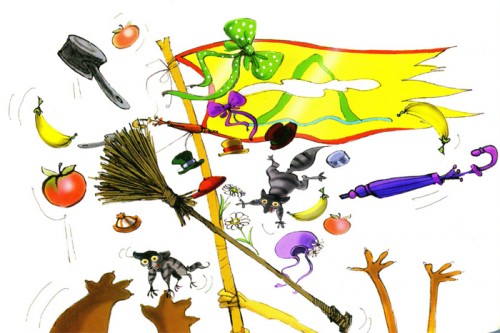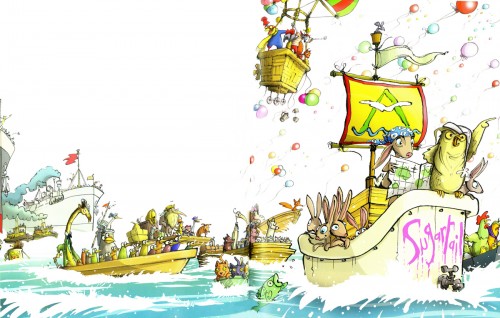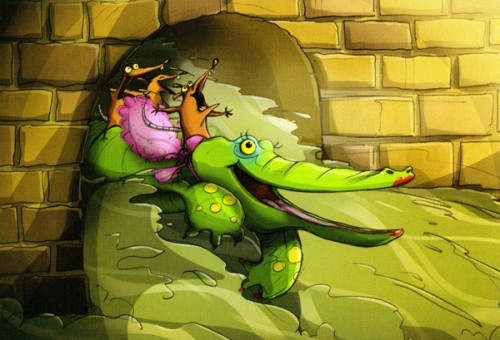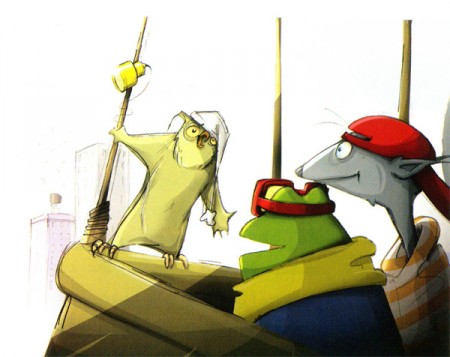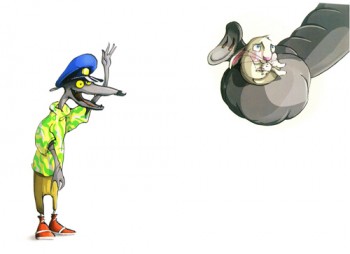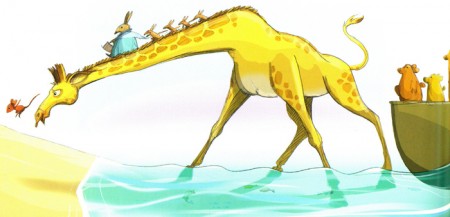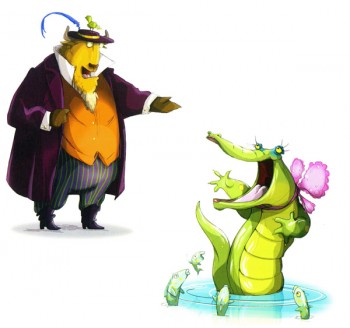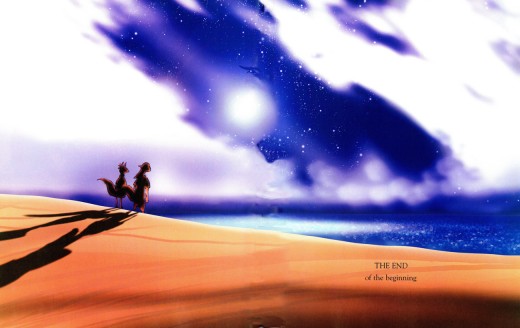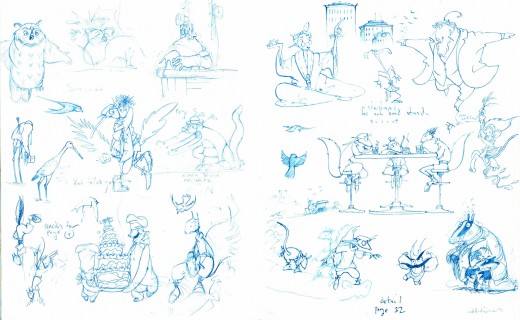Category ArchiveBooks
Books &Hubley &Illustration 24 Sep 2009 07:57 am
Zuckerkandl! book 1
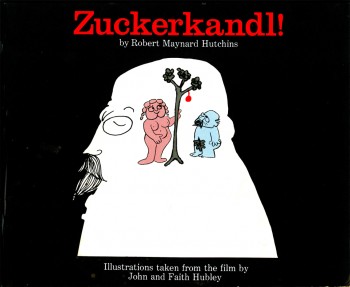 - Weeks back I posted a piece on the John & Faith Hubley film, Zuckerkandl!. There I posted some animation drawings, models and a several pages from the picture-book version of this film, which is a favorite of mine.
- Weeks back I posted a piece on the John & Faith Hubley film, Zuckerkandl!. There I posted some animation drawings, models and a several pages from the picture-book version of this film, which is a favorite of mine.
The story is an animated version of an annual lecture given by author, Robert Maynard Hutchins. The lecture is a parody of philosophical theories created by the author in the name of the fictitious Alexander Zuckerkandl, M.D., Ph.d.
A comment from Tom Shea at that post asked for a specific couple of setups (that I didn’t even approach), and I thought that I should, indeed, post all of the illustrations from the book (which were culled from the original art of the film.) Thus this post; here art those illustrations:
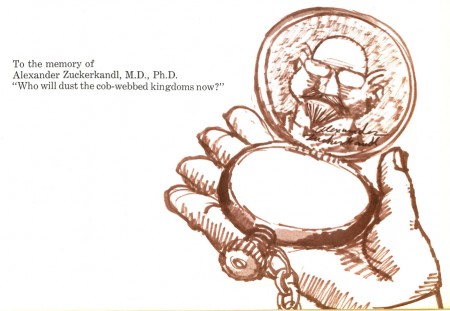
(Click any image to enlarge.) __
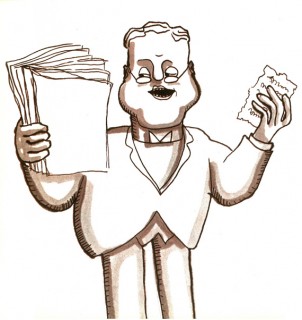 3
3
The remainder of this book will be posted Saturday.
Books 19 Sep 2009 07:44 am
The MGM Chapter
- Last Saturday, I posted a couple of pages of a Terrytoon walk cycle from the book by Gene Byrnes, The Complete Guide to Cartooning. This book has a full chapter on MGM cartoons which is credited to Fred Quimby as writer. The book was a strong inspiration for me when I was a kid, and it still sends a chill up my back and gets me wanting to animate when I look at a couple of those images.
I mentioned this chapter last week and have debated whether to post it. I’ve seen it on line at the blog Sweaterthieves (they posted many of the pages), and the ASIFA Hollywood Animation Archive has posted seven of the chapters that deal with specific cartoonists. However, this chapter seems to warrant some higher resolution images, and I’ve decided to place it here in case you haven’t seen it or don’t know it.
By the way, if you can identify any of the animators or people in the photos, please leave a comment.
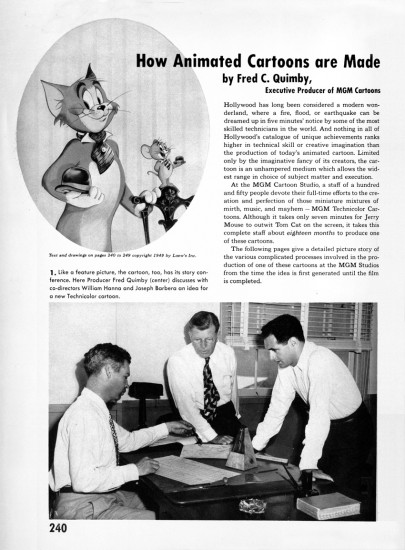 1
1(Click any image to enlarge.)
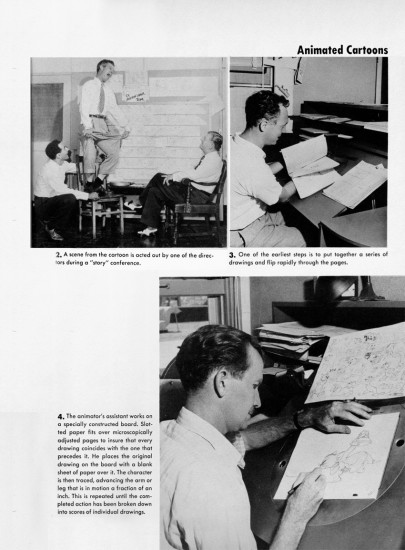 2
2
Upper right: Preston Blair / Bottom: Asst Animator Tom McDonald
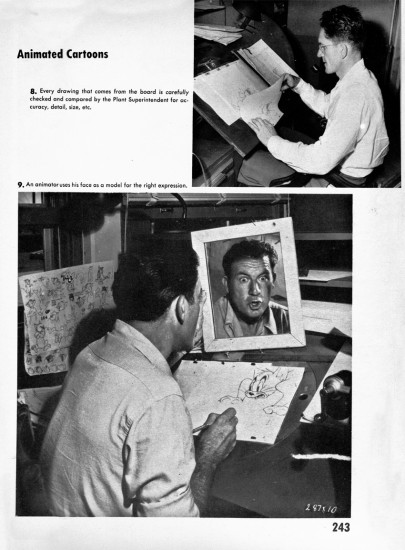 4
4
Upper: Max Maxwell head of checking / Bottom: Irv Spence
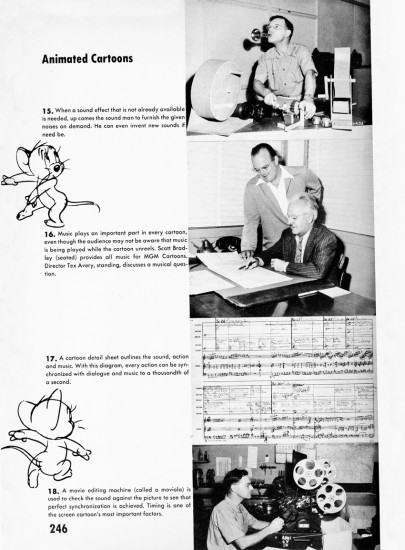 7
7
Middle: (standing) Tex Avery (seated> composer Scott Bradley
And like Sweaterthieves, I’m enlarging the photo of the storyboard. Without the benday pattern and at a higher res, it’s a little easier to read blown up.
This book also includes some pretty great (non-animation) cartoonists. I’ll pick out a handful and post them next week. I still remember every page from my childdhood when I borrowed this book countless times from my local public library.
Bill Peckmann &Books &Illustration 17 Sep 2009 07:39 am
Good Housekeeping 3
 - Bill Peckmann loaned the book of collected Good Housekeeping illustrations that were publishrf bryeen 1938 through 1944. (The illustrations actually began in 1934 and were printed complete in an interesting recent book called Mickey and the Gang which was edited by David Gerstein. That book includes so much more than these illustrations – including the text that went with the illustrations. However, I like the printing, on non-glossy paper, of the 1987 book.)
- Bill Peckmann loaned the book of collected Good Housekeeping illustrations that were publishrf bryeen 1938 through 1944. (The illustrations actually began in 1934 and were printed complete in an interesting recent book called Mickey and the Gang which was edited by David Gerstein. That book includes so much more than these illustrations – including the text that went with the illustrations. However, I like the printing, on non-glossy paper, of the 1987 book.)
I’ve done two other posts of these illustrations (part 1, part 2) and finish them up with this piece.
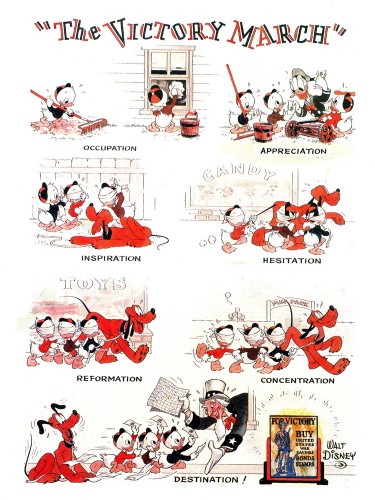 1
1The Victory March, August 1942
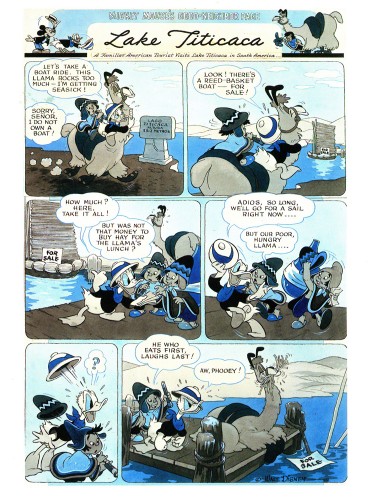 2
2
Lake Titicaca, December 1942
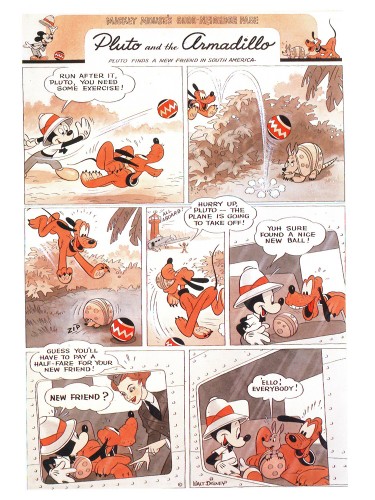 3
3
Pluto and the Armadillo, February 1943
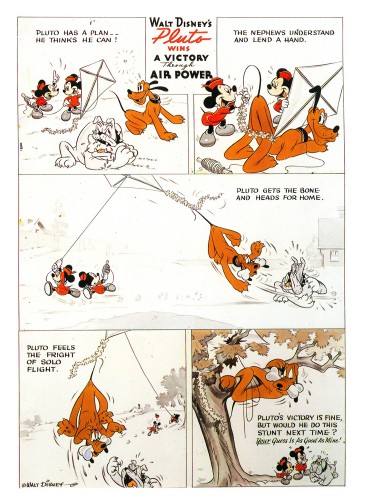 5
5
Pluto wins A Victory Through Air Power, April. 1943
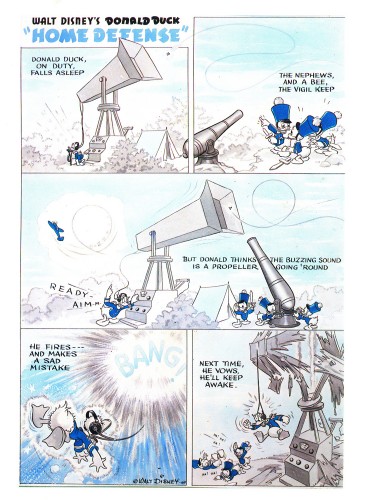 6
6
Donald Duck Home Defense, August 1943
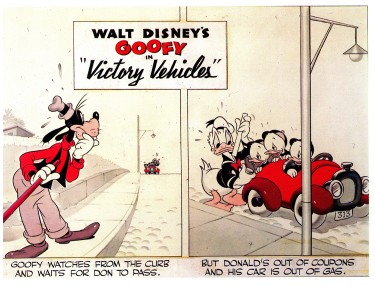 7
7
Victory Vehicles, September 1943
This edition, published in trhe Alexander Gallery catalogue
is really just the upper half of the strip.
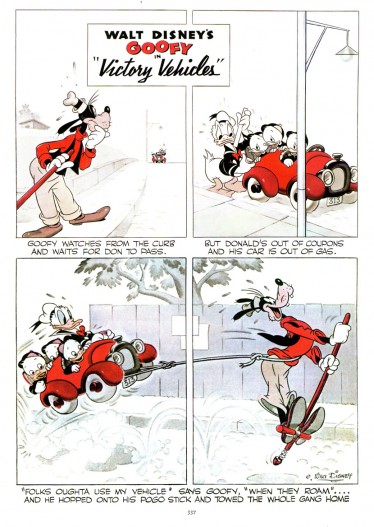
Here’s the whole strip as printed in
Mickey and the Gang.
More white no colored grays.
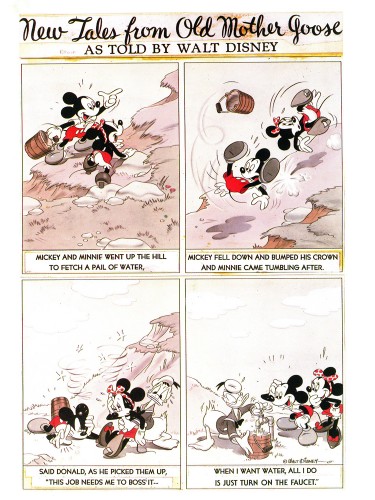 8
8
From 1943 on, the illustrations became “New Tales from Old Mother Goose.”
This was a revision from “Donald Duck’s Mother Goose” that had
appeared in Mickey Mouse Magazine, published in the 1930′s.
Hank Porter and his writers dealt with a more limited subject in a
more comic-strip sense and used the two color process during the war.
Mickey an Minnie Went Up the Hill, October 1943
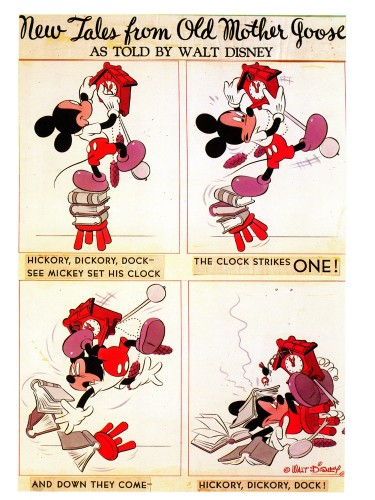 9
9
Hickory Dickory Dock, February 1944
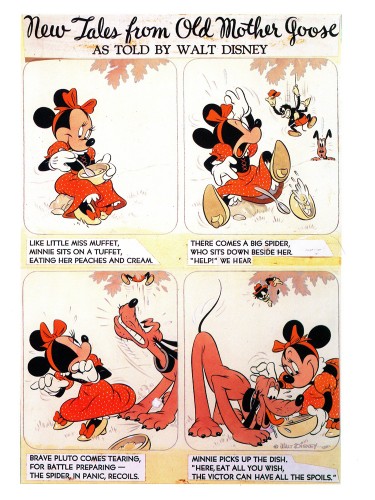 10
10
Little Miss Muffet, May 1944
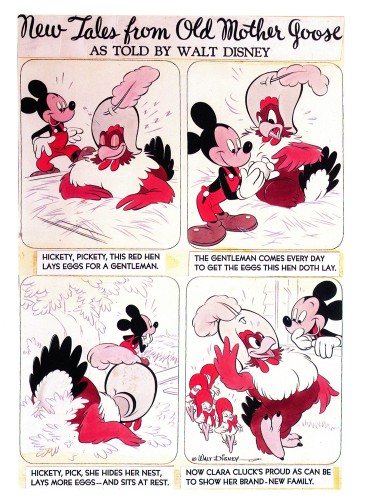 11
11
Hickety, Pickety, June 1944
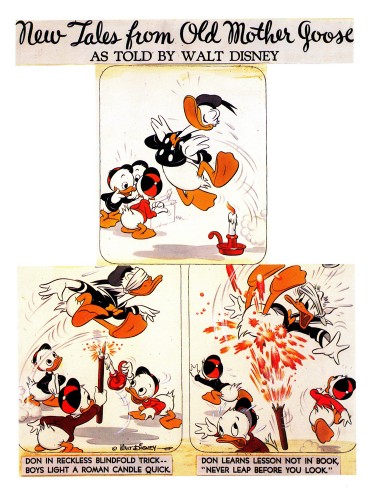 12
12
Don be Nimble, Don be Quick, July 1944
Animation Artifacts &Books &Illustration 15 Sep 2009 07:29 am
Piccoli
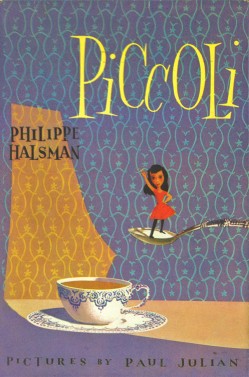 - The brilliant artist/designer/background artist, Paul Julian, illustrated a stunner of a children’s book in 1953. Piccoli is the story of Piccoli Sogni (little dreams) a tiny girl who lives in a matchbox. A stranger gives her as a gift to a sad young boy. She helps to inspire him creatively.
- The brilliant artist/designer/background artist, Paul Julian, illustrated a stunner of a children’s book in 1953. Piccoli is the story of Piccoli Sogni (little dreams) a tiny girl who lives in a matchbox. A stranger gives her as a gift to a sad young boy. She helps to inspire him creatively.
The story is by Phillippe Halsman which he had written for his daughters. He was a celebrated photographer who worked with Salvador Dali on the book Dali’s Moustache. In 1958 he was chosen as one of the 10 greatest photographers in an Internation poll. His 1959 book, Philippe Halsman’s Jump Book, collected more than 200 recognized photographs.
Paul Julian, of course, is well known by animation enthusiasts as one of the principal background artists for many of the most famous Warner Bros cartoons. He also gained some fame for his art direction of the UPA masterpiece, The Tell-Tale Heart.
His work has always seemed just slightly this side of the surreal, to me. His color choices were masterful and the many backgrounds he did reflect his own style. See this excellent post by Hans Bacher on his important blog, Animation Treasures.
John Canemaker loaned me a number of color copies of the book, and I tried to get an accurate read on the colors from the copies, but I suspect they’re still a bit off. Here are Julian’s illustrations for Piccoli:
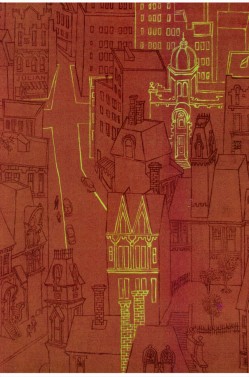
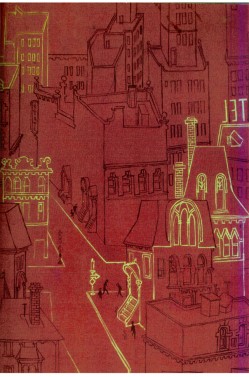
The inner cover of the book.
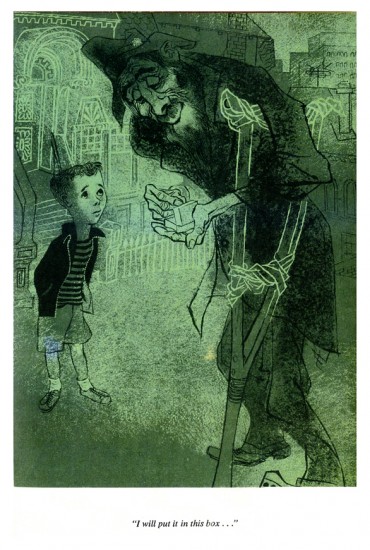 2
2
At times the art looks influenced by Gregorio Prestopino.
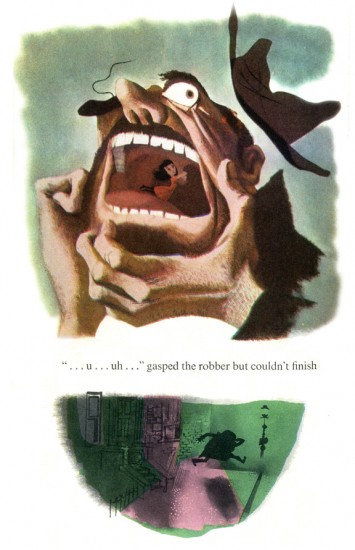 8
8
This is actually a composite of two different illustrations
on two separate pages in the book.
Books &Commentary &walk cycle 12 Sep 2009 07:40 am
Cartooning
- When I was a kid, there were few resources one could turn to for information about animation and the process of making these films. Before computers, information was somewhat more difficult to acquire.
I couldn’t afford many books on the subject. Of course, I owned the Preston Blair book and that other Walter T. Foster book about Making Animated Cartoons (the one that wasn’t drawn very well and included animation examples that just didn’t work.) My treasure was the 1958 Bob Thomas book, The Art of Animation, with its technicolor focus on Sleeping Beauty.
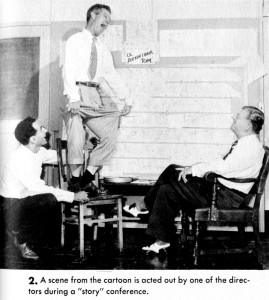 I also clipped every magazine/newspaper article or image I could find about cartoons and saved it in a homemade scrapbook. It would be years before I came upon Mike Barrier‘s Funnyworld Magazine or any other mag, for that matter, that focused exclusively on animation or cartooning.
I also clipped every magazine/newspaper article or image I could find about cartoons and saved it in a homemade scrapbook. It would be years before I came upon Mike Barrier‘s Funnyworld Magazine or any other mag, for that matter, that focused exclusively on animation or cartooning.
There were other books, and I went to the library to check them out monthly. I treasured that library copy of Robert Field‘s The Art of Walt Disney that I read over and over again. I appreciated Nat Falk‘s How to Make Animated Cartoons.
There was one book The Complete Guide to Cartooning by Gene Byrnes that had a chapter on MGM cartoons. This book had some of the greatest photos in it. Animators, inkers, directors, cels and sound effects. The pictures were great in that forties kinda way that just had me drooling animation when I looked at it. (It was published in Jan, 1950.)
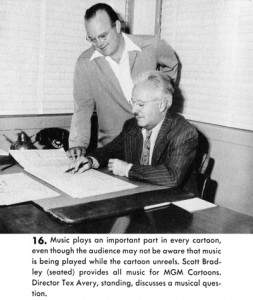 This came to me years ago when I found the animation section of this book on line. I haven’t been able to locate the site again; if I do, I’ll post the link or scan the section myself to post.
This came to me years ago when I found the animation section of this book on line. I haven’t been able to locate the site again; if I do, I’ll post the link or scan the section myself to post.
It came again recently when friend, Tom Hachtman, visited and brought a copy he owned to see if I knew about it. Of course, opening the whole book was like going home again after dozens of years. I knew every page intimately.
Two pages that stood out followed the MGM section and had the same effect within the book of seeing a Terrytoons cartoon after seeing one from MGM. Low rent. The pages look like left overs from Nat Falk’s book (and may, in fact, have been part of one of his books.)
However it amused me to look them over and actually run the peculiar walk cycle through AfterEffects to watch the motion. There are no registration marks, so I had to guess. (I didn’t take a lot of time with this, believe me.)
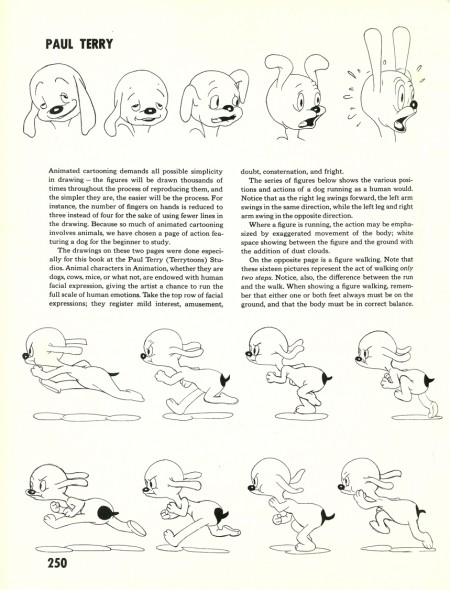
(Click any image to enlarge.)
.
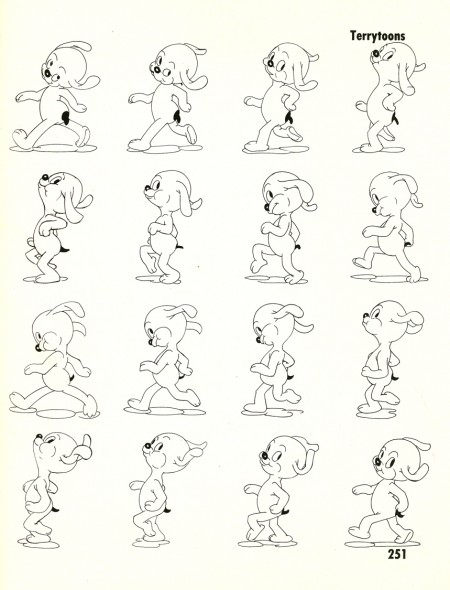
Here’s the QT of the odd pupwalk:
Pupwalk on two’s
I’m not sure who animated this – my guess Connie Rasinski
Click left side of the black bar to play.
Right side to watch single frame.
Animation Artifacts &Bill Peckmann &Books &Disney &Models 08 Sep 2009 07:35 am
Nutcracker Models
- And speaking of the Nutcracker sequence from Fantasia, here are some models from Bill Peckmann‘s extraordinary collection of that sequece. This is probably my favorite of the sections of that feature. There’s some beautiful character animation within it, excellent effects and conceptually the images and music match.
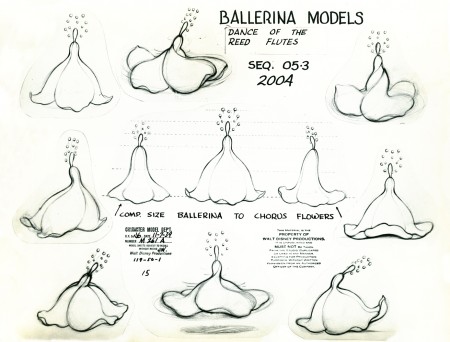 1
1(Click any image to enlarge.)
As this last model shows, the original plan for this sequence included a bug orchestra playing the score – whether part or all of it is questionable – there are a lot of models, drawings and watercolors left behind.
These can be found dominating the book that was released in 1940. There were books for each of the segments of Fantasia, and The Nutcracker Suite is one of them. Oddly, only few of the illustrations are frame grabs from the film, others feature fairies or few of the other characters who made the sequence. Most of the illustrations are these bug characters that don’t appear in the film.
So, to accompany the beautiful models above, I’ve decided to include the bug illustrations from this book – featured below.
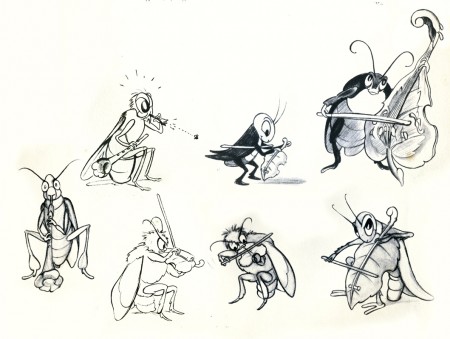 1B&W
1B&W
For more Fantasia items of interest, Bob Cowan is currently showcasing a number of his beautiful pieces on his website.
Books &Daily post 02 Sep 2009 08:35 am
Friends’ Success
Jeff Scher has one of his excellent animated pieces on the NYTimes site. Once again the music by Shay Lynch has supported the piece and completed it at the same time. A fine piece of music as well as a fine piece of film music. The themes anticipate some of the turns that Jeff takes in his anthem to the end of summer. Take it in and wonder how this could ever have been done in cg. These pieces get better and better for me.
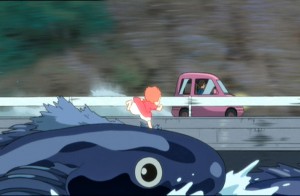 - I’ve recently bought the DVD of Ponyo in Japanese with English subtitles. The film has some strong differences. I saw the movie in English again last night and took some notes. It was my third viewing (2x in theater – once on video) and the film holds up in spades.
- I’ve recently bought the DVD of Ponyo in Japanese with English subtitles. The film has some strong differences. I saw the movie in English again last night and took some notes. It was my third viewing (2x in theater – once on video) and the film holds up in spades.
I’ll report on what differences I’ve heard later this week.
Howard Beckerman was at that screening – he came with John Dilworth. We said hello and Howard handed me a press release:
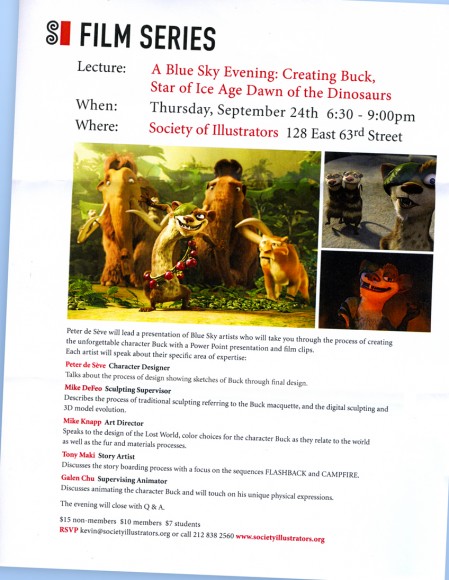
(Click to enlarge.)
Should be an interesting talk, if you have any interest in design or the development process.
- Stephen MacQuignon was a mainstay of my studio for quite a few years. From 1987 through 1993 Steve was the backbone of the coloring department working on many of my principal films – all pre digital. He left animation seeking other fortunes.
Lately, he seems to have found some success with a number of children’s books which he’s recently illustrated. These can be bought on Amazon for a fair price.
Steve tells me that at least three of the upcoming books have yet to hit the market. It’s nice to be busy. We’ll look forward to collecting them all.
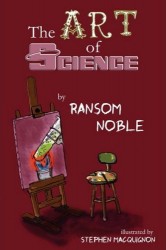 ___
___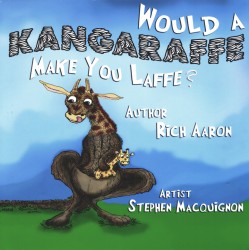
Articles on Animation &Bill Peckmann &Books &Disney &Illustration 27 Aug 2009 07:26 am
Good Housekeeping 2
- Before getting into today’s post, I want to make sure you’ve all seen the notation on Tom Sito‘s great blog today. (An amazing and unique blog if there was one.)
- 1968- Former master animator Bill Tytla’s request to return to Disney was turned down. The artist who animated Grumpy the Dwarf, Dumbo and the Devil on Bald Mountain even offered to do a free “trial animation test” to show he still had it. Disney exec W.H. Anderson wrote him:” We really have only enough animation for our present staff.”
Tytla died later that year.
 - This is the second part of my posting of the illustrations from Good Houskeeping Magazine.
- This is the second part of my posting of the illustrations from Good Houskeeping Magazine.
From 1934 continuing into the late 1940′s, they printed four-color full page previews of newly-released Disney shorts. These illustrations were, at first, painted by Tom Wood, and later by Hank Porter.
The Alexander Gallery collected these illustrations in 1987 for an exhibition, and they published a book of them. Bill Peckmann has kindly loaned me his copy of the book.
These illustrations were published recently in the book, Walt Disney’s Mickey and the Gang. It’s a good book which publishes more art than the Alexander Gallery collector’s item. However, the printing in this book feels more glossy and contrasty. The delicacy of the watercolors is sacrificed. That’s why I’m intent on posting them in the better form. However, this book also includes a lot of other info on the animated films and it includes the text originally published in Good Housekeeping.
Here is the second group of pages:
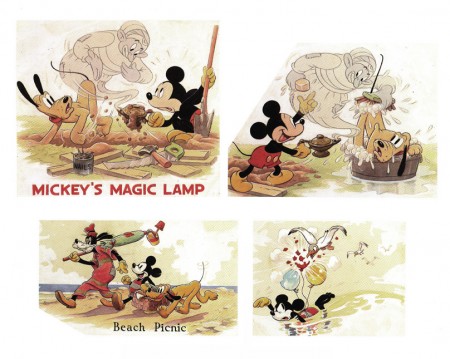
Mickey’s Magic Lamp 1940 | Beach Picnic 1938
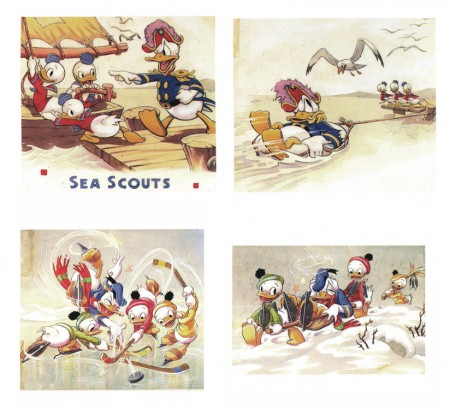
The Sea Scouts 1939 | The Hockey Champ 1939
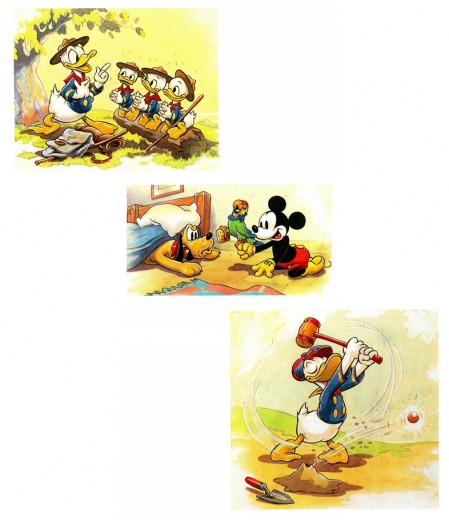
The Good Scouts 1938 | Mickey’s Parrot 1938 | Donald’s Golf Game 1938
Interesting to note the play with Mickey’s ears. These are the ears
with three dimensions used in only a couple of shorts.
Another play on Mickey’s ears – very different.
.
Books &Disney &Illustration 05 Aug 2009 07:18 am
Three Little Kittens book
- I’ve often been curious about the generation that lived through the late 30′s early 40′s. The animated cartoons that were made during this roughly six year period often feature enormously cute characters going through cute storylines. The audiences must have loved it considering the fact that there are so many of these films, including Oscar nominees and winners.
Lend A Paw, The Milky Way, Merbabies, Wynken Blynken and Nod, Two Little Pups, and any of the Sniffles cartoons all featured good animation and high prduction values but terminally cute material.
The Three Orphan Kittens of 1935 was an Oscar winner and as cute as all getout. Not only are these mischievous kittens, but they’re also orphans. The film was directed by David Hand and featured a seuquence by Ken Anderson in which floorboards were animated to try to capture the illusion of 3D.
A number of children’s books were produced from this material, and I offer here the illustrations from one smaller-sized book. It was originally published in 1935 and was obviously such a success that it was reprinted in 1949.
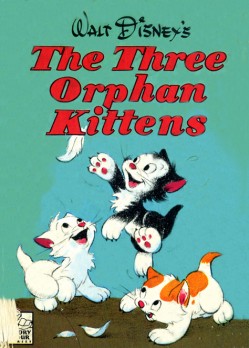
(Click any image to enlarge.)
Here are a couple of preproduction drawings done for the film.
It’s interesting to compare this material with the excellent shorts by Simon Tofield featuring Simon’s Cat. Both utilize pet cats as the featured star; both are lightyears apart from each other. They’re both representative of their time. Two different kinds of cuteness. One works today.
Books &Illustration 25 Jul 2009 07:52 am
High in the Clouds – Part 2
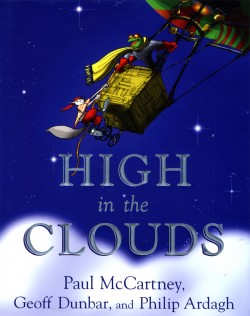 - I know, I know. I gave you the first part oh High in the Clouds weeks ago and haven’t followed up with the second part. Well, here it is.
- I know, I know. I gave you the first part oh High in the Clouds weeks ago and haven’t followed up with the second part. Well, here it is.
This is the storybook by Paul McCartney, Geoff Dunbar and Philip Ardagh that will be made into an animated film, directed by Rob Minkoff.
Dunbar is the animator/director who won lots of awards for some of his shorts and commercials. He’d animated a couple of McCartney songs in the past. Ardagh is a writer, and McCartney is McCartney.
Minkoff was the co-director of The Lion King, director of Stuart Little and The Haunted Mansion.
I have no real knowledge of this, but I assume it’ll be done in CG. Why else hire Minkoff when Dunbar’s already designed the hell out of the idea? Hopefully, it won’t look like all the other crap out there, but I have no confidence in anyone anymore.
So here are the rest of the illustrations. I haven’t read the book, and am not sure I will. It looks like a reworked/printed animated program, as it is.
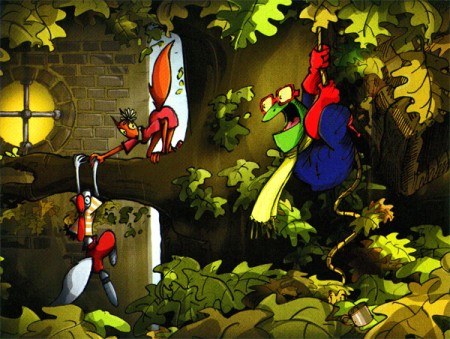 22
22(Click any image to enlarge.)
